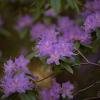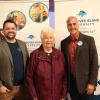October 29, 2006 - 4:00pm
Submitted by Michel Vallee, RPF
Forestry Department
Every year, Malaspina University-College forestry faculty take the second year class on an international field trip that allows students to experience other cultures and approaches to forest management.
This year, 12 Forest Resources Technology diploma program students, four faculty members and two industry representatives spent 12 days in Hungary, Romania and Eastern Austria on a tour that was organized through the University of West Hungary in Sopron, Hungary.
The group left Vancouver on April 15 and, after a recuperation day in Budapest, was off to north-eastern Hungary and then on to the Carpathian Mountains of eastern Transylvania. There the group was hosted and taken on tour by local biologists, foresters and parks management specialists from the Romanian forestry and parks authorities.
The focus of the field visits and discussions during this portion of the trip were on mountain forestry and the preservation of local sites with high recreation and tourism values but not at the exclusion of timber management and harvesting. In the traditional Romanian style, most explanations on local practices and sites always included colourful and historical stories and legends; however, the one that fascinated the students above all was that of the most famous and infamous of Transylvanian characters and, as such, a visit to Bran Castle had to be included in the agenda.
From the Brasov area of central Romania, the group traveled to Sopron in northwest Hungary via the great southern Hungarian plain and the famous Lake Balaton area. Along the way, we were hosted and toured by a number of foresters from a number of state forestry companies who explained all aspects of Shelterwood Silviculture Systems for managing everything from European beech and hawthorn to a great number of oak species for fuel wood, lumber, wildlife and tourism values.
During this portion of the trip, a very interesting afternoon was spent at the Kiskunsag National Park located in a very dry desert region of the great plain. In this area, as in most of the country, the ecology of the land has been influenced by centuries of human activity and, through this intervention, has developed a unique Juniper ecosystem structure resulting from grazing and fuel-wood harvesting. However, now the area is within a fully protected national park, the vegetation structure is changing to a more natural complex that is not as appreciated by locals as that found under the influence of human activity. Thus, the whole notion of allowing a certain level of animal husbandry and limited harvesting in the park is under great debate.
In Sopron, the group visited a number of local sites including the Ferto Hansag National Park shared with Austria and considered one of the largest bird sanctuaries in central Europe. We also visited the site of the famous 1989 border crossing where thousands of eastern block citizens crossed into the “west” and initiated the collapse of the “iron curtain” and communism in eastern Europe.
One of the last forestry days of the trip was spent at the University of Vienna’s 930 hectare forestry field school in Forchtenstein in south eastern Austria. The head of the field school, Dr. Josef Gasch, and several faculty members from Vienna took the group to an Austrian forestry presentation that included an afternoon visit to local forest sites where we saw and discussed commonly used silvicultural systems and techniques; we also saw harvesting systems designed for steep terrain including a small portable truck mounted skyline and a ground lead tractor driven system both used for thinning a mixed spruce and beech stand.
The trip was developed with the intention of linking current silvicultural and harvesting practices of the area to historical and cultural demands and uses of the forest and, thanks to our hosts, our objectives were more than met.
The students raised the greatest portion of the necessary funds for the trip through a variety of projects including tree planting, pruning, and road side clearing contracts and firewood sales. A number of Vancouver Island companies and organizations including TimberWest Forest Corp., Western Forest Products, Vancouver Island Helicopters, Island Timberlands, Coastlands Wood Industries, Cougar Timber, and the Cowichan Valley HooHoo Club contributed to the effort through donations. Because of these companies’ generosity, individual cost per student was kept reasonable; faculty and industry representatives who participated in the project covered their own costs.
The group would like to thank all those who supported the trip either through donations, contract or organization efforts.
Tags: In the Community






